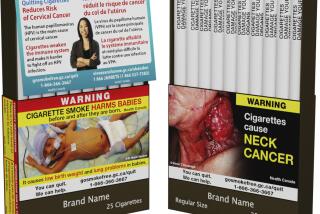Cigarettes to carry grim warnings
In the first major change to cigarette packaging in a quarter-century, the Food and Drug Administration said Wednesday it would require graphic warning labels that cover half a package’s front and rear and the top 20% of all cigarette ads.
The labels will feature either drawings or photos illustrating graphically the dangers associated with smoking and will be accompanied by text stating that smoking is addictive or that it kills. The pictures feature such things as a diseased lung, a corpse and a man smoking a cigarette through a tracheotomy tube. They are not quite as grim as some used in other countries, but regulators hope they will be sufficiently frightening to keep young people from beginning to smoke and to strengthen the will of those who are attempting to quit.
“We want to make sure every person who picks up a pack of cigarettes knows exactly what the risk is they are taking,” Health and Human Services Secretary Kathleen Sebelius said at a news conference.
Current regulations require only a written warning on the edge of the cigarette pack and a similar small warning at the bottom of ads.
“These are great! I am pleasantly shocked that HHS is doing this,” said Stanton A. Glantz, a tobacco control expert at UC San Francisco, echoing the response of most observers. “There is no question but that strong graphic warning labels work” -- and that, in particular, they influence children, he added.
“Right now we have the weakest warning labels in the world,” Glantz said. “Now we will be right up there tied for the strongest.”
But John F. Banzhaf III, a professor of public interest law at George Washington University and executive director of Action on Smoking and Health, said he was “quite disappointed” in the action. “Of all the things that they could do, HHS has done nothing more than exactly what Congress told them to do, and not one iota more,” he said.
Banzhaf also noted that Canada has had strong package warnings since 2000, and that “other jurisdictions have stronger warnings, more graphic pictures.”
The FDA is looking at 36 different potential labels, which can be viewed at www.fda.gov/cigarettewarnings. The agency will select nine of them by June 22, and cigarette manufacturers must begin putting them on packages and advertising by Sept. 22. By Oct. 22, manufacturers will no longer be able to distribute cigarettes that do not bear the new warnings.
Federal agencies have been concerned that smoking rates, which declined from about 42% in 1965 to under 21% in 2004, have remained flat since then. “That’s bad news,” Sebelius said. “Every day, 4,000 young people try cigarettes for the first time and 1,000 continue to smoke.”
Tobacco use causes at least 18 different cancers, not just lung cancer, according to the American Assn. for Cancer Research. Smoking also plays a major role in the onset of cardiovascular disease.
An estimated 450,000 Americans die prematurely as a result of smoking-related disease every year and 8 million suffer chronic diseases at a cost to the economy of nearly $200 billion annually. Most of those deaths and diseases are preventable.
The goal of the new actions by the Department of Health and Human Services is to bring the smoking rate down to 12% by 2020.
A key step was the passage of legislation in June 2009 that, for the first time, gave the FDA power to regulate tobacco products. Since then, the agency has taken a number of steps, including banning the practice of giving out free samples, halting advertising in youth-oriented magazines, and banning misleading terms like “light,” “low-tar” and “mild” from advertising.
Medicare has also changed its rules so that smoking cessation products are available to any beneficiaries who want them, not just those who have lung disease, as was the previous practice.
“There is still a long way to go to reduce the enormous burden of death and disability, but we can make progress,” said Dr. Margaret A. Hamburg, FDA commissioner.
Other potential actions include further raising taxes on cigarettes and increasing the cost of health insurance for smokers. Dr. Howard K. Koh, assistant secretary for health, noted at the news conference that every 10% increase in the price of cigarettes had been shown to decrease smoking by 4%.
Banzhaf also noted that it had been legal for several years to charge smokers more for health insurance to help offset the extra $12,000 per year in costs they incur, and that the federal healthcare overhaul specifically calls for the increases to be more widely used beginning in 2014. However, that surcharge has not been applied to any significant extent.
Tobacco companies have had little response to the announcement. But R.J. Reynolds has filed suit to block the original law that called for the large warning labels, arguing that the warnings will obscure the companies’ brands, making it hard for consumers to distinguish among them.
More to Read
Sign up for Essential California
The most important California stories and recommendations in your inbox every morning.
You may occasionally receive promotional content from the Los Angeles Times.










